|
KING OF THE ROAD
King Of The Load, more like.
One of the themes thrown up by the
Driv3/10er debacle was the age-old question
of empirical versus subjective judgement. While it's easy to
specifically identify the technical inadequacies and bugs in Atari's
half-finished travesty of a game, the title's inherent design
failings are actually a far worse problem, and those are to some
extent a matter of opinion. Implausibly, there are some people out
there who actually seem to like the game's ridiculously
shoddy AI, for example. (Presumably enjoying the fact that the enemies'
habit of standing stock still in their pre-scripted positions
regardless of the fact that you're riddling them with bullets makes
them rather easier to kill, enabling the player to get away from the
atrocious on-foot sections of the game and back to the less-abysmal
driving sections faster.)
Now, clearly these people are cretins,
but if somebody enjoys a game despite the idiotically terrible way
it's been designed, you can't really tell them that they aren't
enjoying it. Some game design, however, is so bad that it transcends
being a matter of opinion and can actually be empirically measured.
The King Of Route 66 is such a game.
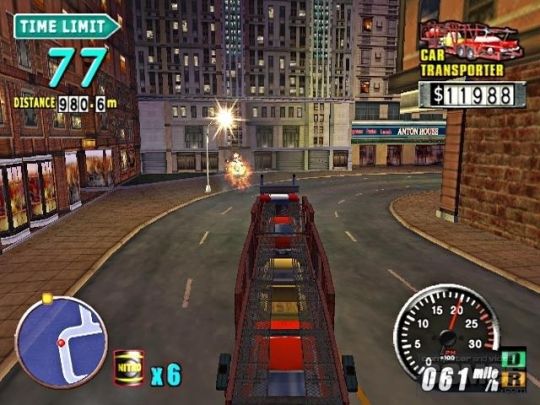
Good luck steering through here at speed.
Your reporter's
been keen to play this game for quite a while. Sega's original
trucking coin-op 18-Wheeler was shallow and short, but since all
your correspondent has ever really asked from a games console is to
provide him with an arcade in his home, the minimally-expanded
Dreamcast version still provided a good few hours of fun. This is - as far as your reporter knows - a home-only sequel,
which takes the same theme and extends it into something rather more
suited to the hefty price tag of a modern console title. (That said,
it wasn't until play.com put it up for a bargainous £6.50 in their
"Make Us An Offer" sale that the lock was finally prised off the WoS
piggy bank and the purchase made.)
The King Of Route 66 offers a number
of game modes, including a fun Crazy Taxi-style challenge game (as
also seen in 18-Wheeler), but we're going to concern ourselves here
with the main "story mode", which sets the player amid a plot
involving "Tornado", an evil trucking company monopolising the famous
trans-American highway, driving competing companies away with brutal
violence and intimidation blah blah blah. Mostly, the plot is there
to justify the inclusion of some nicely-rendered, dreadfully-acted cutscenes which, fortunately, can be skipped through even on first
showing by pressing the Start button. Sadly, however, such
consideration for the player starts and ends with that gesture.
To illustrate that point, what your
reporter's going to do is take you through a typical game of The
King Of Route 66, armed with not only the traditional joypad, but
also a stopwatch and notebook. Any aspiring or actual game developers
reading might want to note down the below as a kind of handy
one-stop tutorial in the sort of game design that one day, in a
better world than we currently inhabit, will result in the
perpetrators being strung up by their little toes from a lamp-post
with piano wire, and savagely beaten by burly dockers armed with
wooden clubs with nails hammered into them, until they resemble the
contents of a discount abbatoir's rubbish skip wrapped up in a dirty
net curtain.
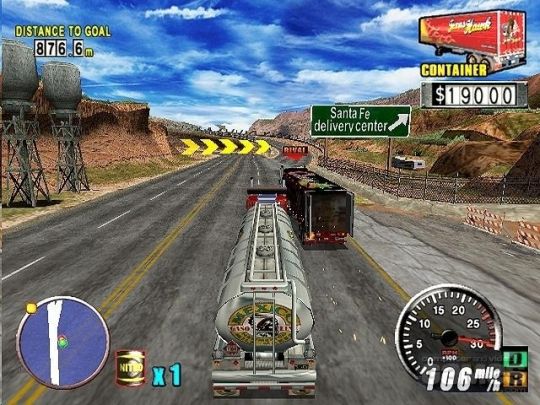
You can often smash through the big arrows,
though half the time it'll just leave you in a dead end.
THE
KING OF ROUTE 66 - A TIME AND MOTION STUDY
00:00
- Switch PS2 on. Ooh, look at the pretty twinkly lights! Admire the
elegant 50/60Hz select screen, and all the lovely logos of the many
super people who brought you this game.
01:16
- Finally get to "Start Game" screen. (Note that this is with the
intro sequence skipped the second it begins. If you choose to watch
it, add another 1m 36s to this time.)
- Press Start, and select all the default options by hammering the
fire button as fast as possible.
02:36
- After hammering the fire button some more to skip through all the
scene-setting conversations without reading them (add 1 minute if
you actually want to know what's going on), the words "Get Going"
appear on the screen and you finally get to drive your truck.
03:08
- After just 32 seconds of actual gameplay, you lose to the Tornado
trucker. And you will lose, because without advance knowledge
of the level, you have absolutely no chance whatsoever of beating
him to the level's Goal. Even after a few runs through the level,
you'll need to drive absolutely flawlessly, use your nitro-boost,
take every possible shortcut and cut every possible corner to have a
chance of beating him over the finish line by inches.
03:30
- Having selected "Retry", you endure 22 unskippable seconds of the
game messing around and showing you the stage intro sequence again
before you're given control again.
03:52
- Using superhuman skill, you slide over the finish line
fractionally ahead of the Tornado trucker and complete the stage.
04:58
- Not wanting to go through that again, you accept the game's offer
to save, which takes a trifling 10 seconds or so. Then there's just
another 54 seconds of conversation-skipping and loading to sit
through until it's time for another "Get Going".
05:32
- Another short stage, with the finish line reached in just 34
seconds. So far you've spent about a minute and a half actually
playing the game, and four minutes helplessly watching the screen.
Briefly, you ponder how wonderful it is to be living in the modern
console age, rather than waiting five minutes for a Spectrum game to
load off a cassette tape.
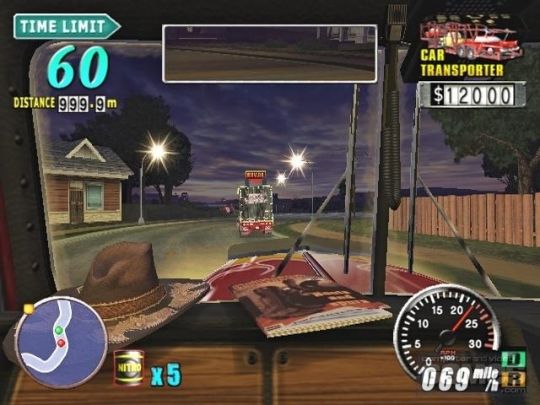
As with all driving games except Ridge Racer,
the interior view is for chumps.
06:40
- Another quick save, another load of yakking and disc-accessing,
and you arrive at one of The King Of Route 66's advances over its
coin-op predecessor. At various points in the game, you can select
your next mission from a choice of two or three, labelled "Easy" and
"Hard" if there are two, with a "Normal" option in between if there
are three. Since the game is extremely unforgiving, you'll probably
start off by selecting the "Easy" mission, since it offers just as
much playing time as the others.
06:50
- Some more loading brings you to a simple little pre-stage where
you have to hook up your truck to its cargo. If you reverse into it
too hard you'll damage your truck and lose money, whereas hooking up
safely will get you a nitro-boost or two for the next stage as a
bonus.
06:55
- Pre-stage completed. Time for some loading.
07:19
- At last it's time for the first decent continous slice of gameplay.
Once more you have to race a Tornado truck to your destination. Not
only is your rival faster than you, he also doesn't mind thrashing
all over the road, like an angry rattlesnake having an epileptic
fit, in order to prevent you from passing him. What's more, if you
should misjudge a corner or collision and end up facing in slightly
the wrong direction, you can wave goodbye to about 20 seconds (and
any chance of winning the stage) while you manouevre back on track
and laboriously accelerate back up to speed. Your opponent, however,
can survive being rammed into a wall and left facing 180 degrees the
wrong way, entirely stationary, and yet still be overtaking you
again at top speed three seconds later.
08:44
- One minute and 25 seconds of uninterrupted racing on, you
somehow implausibly manage to win the stage even against these
unfair odds. Well, you did pick "Easy", didn't you?
09:47
- Your reward is a shorter-than-usual 1m 03s of loading, in order to
get to a pointless mini-stage where you drive to your next job, for
all of 13 seconds.
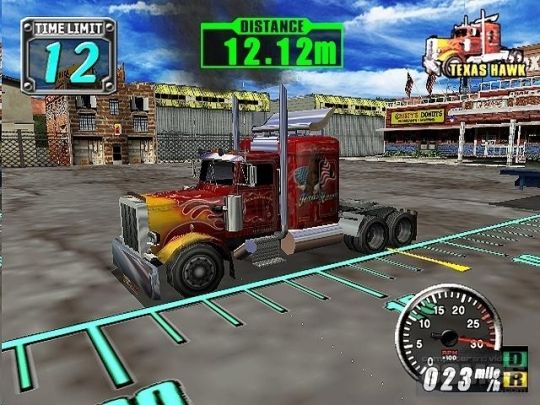
The tricky "reverse in a straight line into
your cargo" sub-stage.
10:00
- Another job-selection point, this time with only "Easy" and "Hard"
missions to choose from. You decide to stick with a winning formula
and select "Easy".
10:38
- Loading, five-second hook-up-the-cargo pre-stage, more loading,
start the actual stage.
12:00
- Stage completed.
13:32
- Another save, more chatter skipped through, and a couple of
cutscenes also ignored. Add another minute if you wanted to see the
plot develop. Next stage begins.
14:05
- Next stage ends, with an incredibly obvious shortcut seeing you
leave the evil Tornado trucker watching you sail over the line in 33
seconds flat.
14:59
- Another loading, saving and yakking interlude twice as long as the
sliver of gameplay preceding it leads you to the next "race to your
next job" section
15:29
- Which takes 30 seconds.
16:15
- Must be time for another minute of loading, then. At this point,
you decide to heat things up a little and select the "Hard" mission
from the two offered. Thankfully, the game crashes.
TIME
AND MOTION STUDY ENDS
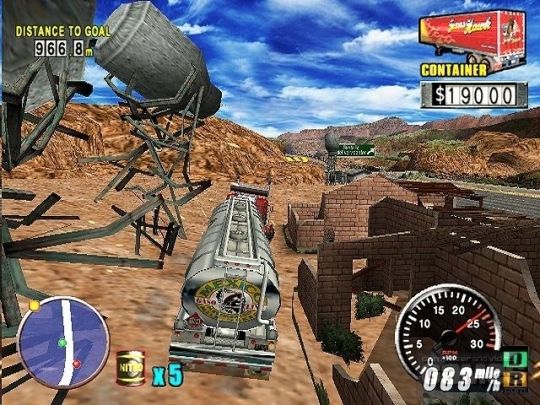
Smashing through the scenery like this is fun, and will without any
doubt whatsoever lead to you failing to complete the stage. The game
permits absolutely no errors if you want to finish a level.
Particularly alert viewers will have
noticed that by this stage in proceedings, we've been sat in front
of our PS2 for over 16 minutes, and have spent just five
minutes of that time actually in control of a truck. For more
than two-thirds of our total gaming time, we've been sat watching
loading screens, and desperately pummelling at the X and Start
buttons in order to skip past endless dialogue and cutscenes. Had we
chosen to submit ourselves to the full King Of Route 66 CIneMatIc
muLTiMedIA eXpERIenCe and watch the exciting plot develop, we could
have bumped that total time up to around 22 minutes without
adding a second's extra gameplay. Ploughing further into the game
makes no significant difference to the ratio of playing-versus-spectating,
but it'll take superhuman effort to stand the grinding tedium for
long enough to find that out. We did it so you don't have to.
The developers know how utterly dismal
this is, of course. But rather than do their jobs properly and
construct a game where you don't spend three minutes sitting on your
arse for every minute of play, they've attempted to compensate by
making The King Of Route 66 so ridiculously unforgiving that you'll
need several attempts at each level before you figure out the one
perfect approach the game wants you to take if you're going to win.
In that regard it bears a close resemblance to titles like Midway's
jet-boat racer Hydro Thunder, where the use of "bonus" boosts and
"shortcuts" are in fact entirely compulsory if you want to stand any
chance at all of victory against cheating opponents and impossible
time limits. Even screwing the difficulty tighter until it squeaks
makes little difference in this case, though, since failure in a
typical 30-second stage will still force you to endure 25 seconds of
loading/unskippable intro before you can start the level again.
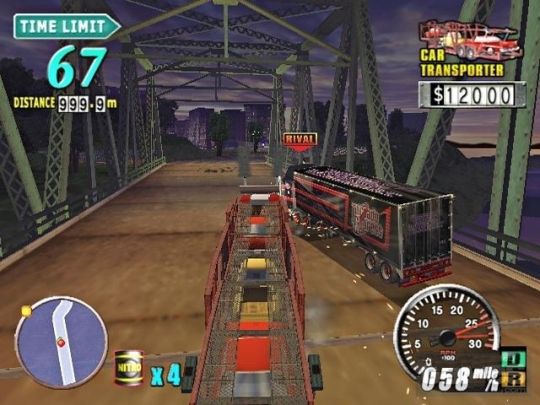
There's very little point in overtaking your rival until three feet
from the finish line.
It must have taken considerable effort
to so completely ruin such a simple, instantly-appealing, enjoyable
game as 18-Wheeler without changing its core gameplay. Playing The
King Of Route 66 is a relentlessly, spirit-crushingly miserable
experience, and it's that way because the people who developed and
programmed it are idiots who haven't given a moment's thought to the
people who are actually going to play it. But why do they think that
way? What are they, stupid or something? Or what?
Many years ago your brave
correspondent, largely by accident, found himself taking a degree
course in BSc Computing at Napier University in Edinburgh. The
tutors there - with the course's main goal being to have its
graduates get jobs coding software for big banks and the like,
rather than in the entertainment business - brutally enforced the
concept of "structured programming". In a nutshell, the important
thing in structured programming is that your code is neat and tidy,
rather than efficient. It's more important to banks that other
people can make sense of the code after you've written it, than that
it's 5% faster.
Accordingly, everything basically has to be written
in one great big nested subroutine, and using a "GOTO" command - the
absolute height of bad structure - under any circumstances
whatsoever was a surefire route to failing a module. Coding like
this means the program is easy to follow, but is made up of
countless little segments rather than flowing smoothly in one
continuous operation, and the huge amount of nesting makes it slow
and cumbersome as it methodically threads its way through to the
segment of code it needs at any given time, rather than just leaping
straight to it immediately and to heck with the consequences. (Also,
writing programs in discrete segments isn't only a technical issue
of code speed - if you're educated to be in that frame of mind,
you'll actually design things to operate like that, regardless of
how inappropriate it might be in an arcade-gaming context.)
This is, of course, entirely sensible
practice when you're coding software for banks, where nobody using
the program needs to be kept amused or entertained by it, and it
doesn't need to go especially fast. Where
things go wrong is where people learn to code like that, then get
jobs with games companies, and nobody thinks to take the simple step
of beating them to death with clubs when they start writing
videogames in the same way. Doubtless The King Of Route 66's code is
extremely tidy, but hanging around for 60% to 80% of your playing
time while you wait for it to slowly amble to the actual game bits is less fun than
working in a bank, and if you fancy yourself as a game developer
you'd do well to learn its lessons.
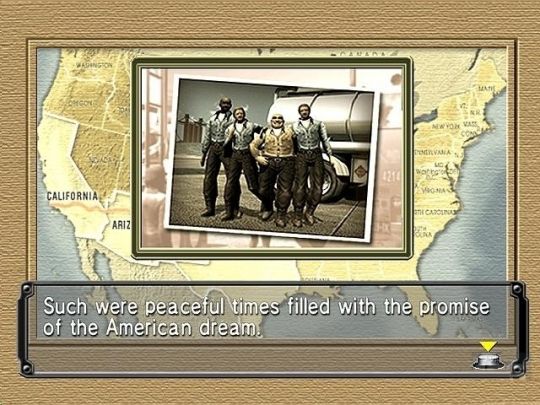
Press the button to blow up the petrol tanker and incinerate the programmers
(pictured). |

